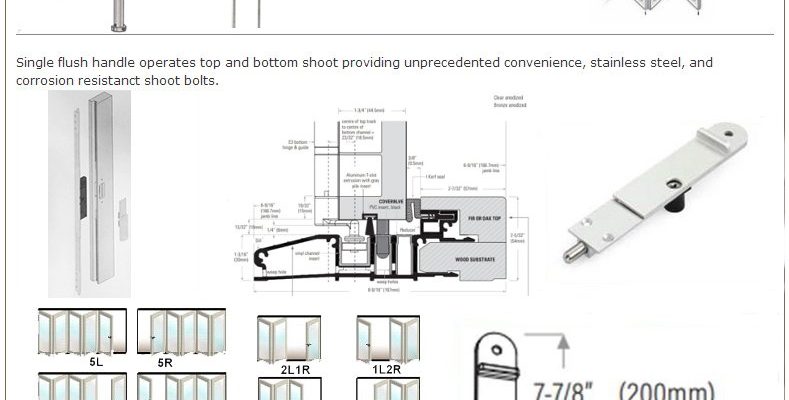
Imagine you’re planning a weekend project to install bifold doors. You might be excited but a little intimidated. What parts do you need? How do you ensure everything functions properly? Don’t worry; I’ve got you covered. We’re diving into the nuts and bolts of bifold door hardware, so by the end, you’ll feel like a pro.
What is a Bifold Door Hardware System?
A bifold door hardware system is the collection of components that allow bifold doors to open and close smoothly. These doors fold in on themselves, making them ideal for spaces where you want to maximize both light and accessibility. The hardware system includes tracks, hinges, rollers, and other essential parts that work together to create a seamless experience.
Understanding how each part contributes is crucial for anyone looking to install or troubleshoot bifold doors. It’s not just about having the right tools; it’s about knowing how to use them. Here’s a closer look at what makes up this system.
The Track System: Guiding the Way
The track system is arguably the heart of the bifold door hardware. This is where the magic happens. The bifold doors hang and glide along the tracks, allowing them to open up without hassle.
Typically, there are two types of tracks: top-mounted and bottom-mounted. Top-mounted tracks are fixed to the ceiling and allow for a clean look. On the other hand, bottom-mounted tracks are secured to the floor, providing extra stability.
One vital aspect to consider is alignment. If the track isn’t installed correctly, your doors can stick or even derail. Honestly, taking the time to ensure your track is level will save you a boatload of trouble later on.
Hinges: The Unsung Heroes
Next up are the hinges. These small but mighty components connect the door panels together. They allow the doors to fold in on themselves smoothly.
There are different types of hinges you might encounter: concealed hinges and surface-mounted hinges. Concealed hinges are hidden from view when the door is closed, giving a sleek appearance. In contrast, surface-mounted hinges are more visible but can offer different aesthetic vibes.
If you happen to notice your doors aren’t folding correctly, it might be worth checking your hinges. Misalignment here can lead to wear and tear over time, so keep an eye on them.
Rollers: The Smooth Operators
Now, let’s talk about the rollers. Think of them as the little wheels that help your doors glide effortlessly along the track. Each bifold door typically comes equipped with a pair of rollers, and they play a key role in the smooth operation of your doors.
Rollers come in various materials, but durable options like nylon or steel are super common. Each material has its pros and cons—nylon tends to be quieter, while steel handles heavier doors better.
If your door seems stuck or noisy, faulty rollers are often the culprit. You might find that a simple roller replacement can solve many of these issues.
Emergency Stops and End Caps: Safety First
Safety should always be a priority, which is where emergency stops and end caps come into play. The emergency stop prevents the doors from swinging too far open, which could potentially cause damage. End caps are like the finishing touch; they cover the ends of the tracks and keep everything looking tidy while also preventing debris from entering.
These components are often overlooked but can greatly enhance the safety and longevity of your bifold doors.
Connecting Elements: The Bigger Picture
Every part in the bifold door hardware system works together to create a seamless experience. The connecting elements include everything from screws and brackets to spacers and shims. Each piece may seem insignificant alone, but together they complete the assembly and ensure your doors function correctly.
Understanding these connections is beneficial for troubleshooting, too. If a panel seems off or the operation isn’t smooth, checking these pieces can reveal the source of the problem.
Installation Tips for Beginners
If you’re thinking about installing bifold doors, here are a few tips to make the process easier:
- Measure Twice: Always double-check your measurements before cutting any materials. Precision is key to success.
- Follow Manufacturer Instructions: Different brands may have varying installation processes, so be sure to read the manual carefully.
- Gather All Tools: Before starting, gather all necessary tools like a level, screwdriver, and drill. This will save you time and frustration.
- Take Your Time: Rushing through the installation can lead to mistakes. Take your time to ensure everything is aligned and secured correctly.
These tips should make your installation process smoother and help you feel more confident in your work.
Troubleshooting Common Issues
Sometimes, even the best installations can run into issues. Here are a few common problems and how to tackle them:
- Doors Get Stuck: This often relates to misaligned rollers or tracks. Check to ensure everything is mounted properly and lubricate the rollers if needed.
- Nose or Loud Operation: Noisy doors may indicate worn rollers. Consider replacing them and check for any debris in the track.
- Panels Won’t Fold: If the doors refuse to fold correctly, examine the hinges for tightness or misalignment.
Being informed about these issues can save you time and stress later on.
In conclusion, understanding the components of a bifold door hardware system isn’t just for the pros. With a bit of knowledge, you can tackle installations or troubleshoot issues confidently. These doors can be a stylish addition to your home, and knowing how they work ensures you get the most out of them. So, whether you’re planning an installation or just curious, you now have the information to make informed decisions about bifold doors and their hardware.
